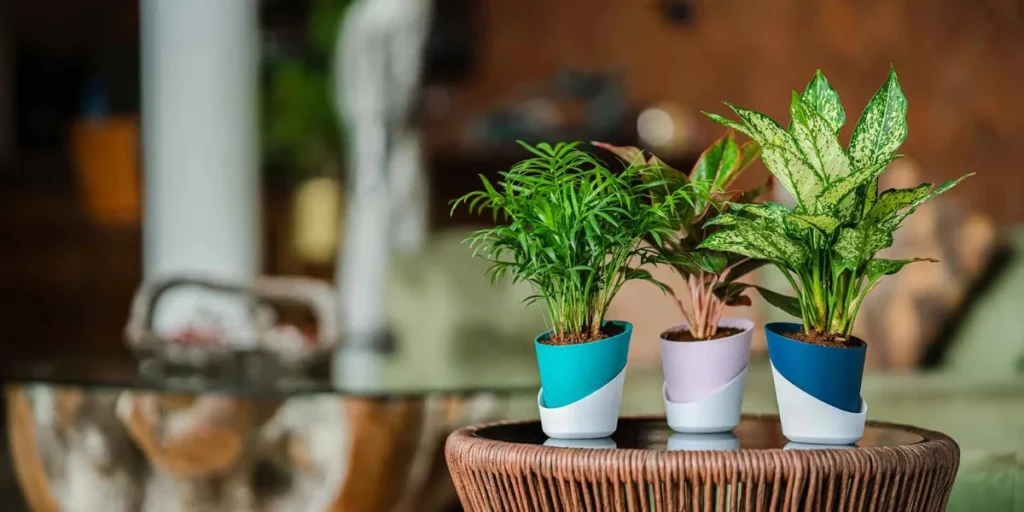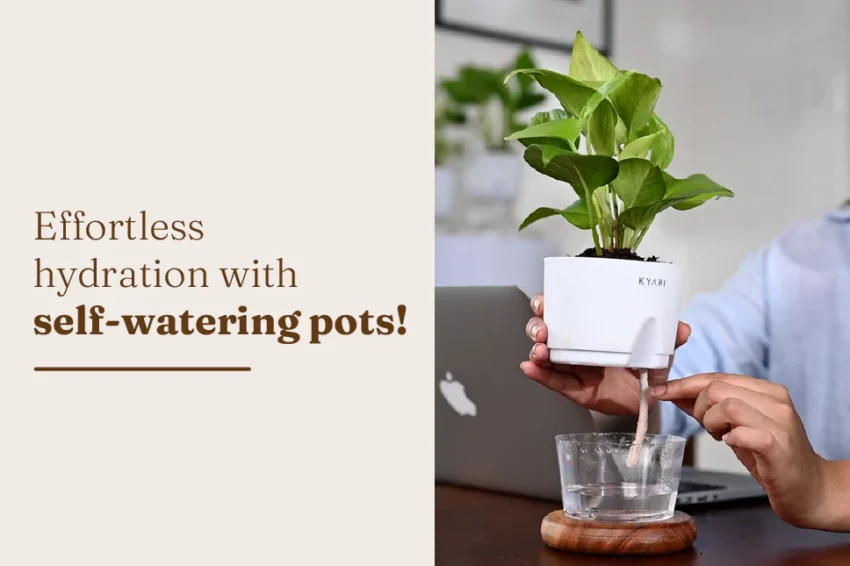Yes, self-watering pots really work. They can keep soil evenly moist, reduce watering stress, and save time for home gardeners. But they are not magic. They work best when you choose the right plants, potting mix, and size. In this detailed guide, you will learn how they function, their pros and cons, and how to use them effectively for balcony gardening, terrace gardening, and urban farming in India.
What is a Self-Watering Pot?

A self-watering pot (also called a SIP or sub-irrigated planter) has two main parts.
On top, there is the planting chamber with potting mix.
Below, there is a water reservoir.
A wick or soil column connects them, allowing water to move up from the reservoir to the roots through capillary action. Many designs also have a side overflow hole to release extra rainwater or excess watering.
Key idea: The plant “drinks” water from below. The soil remains moist but not soggy if the pot is designed well and you do not overfill the reservoir. Capillary action and plant transpiration pull water upward as the top layer dries.
Do They Really Help Plants Grow?
In many cases, yes. Self-watering pots can promote healthier growth, provide consistent moisture, and reduce daily maintenance. This is especially useful for vegetables, herbs, and flowers that require steady watering. Studies show that subirrigated planters improve plant health, water-use efficiency, and yields compared to regular top watering.
Also Read Stop Food Waste Now: Easy and Practical Tips for Every Indian Home
Benefits of Self-Watering Pots
- Even Moisture Supply: Reduces plant stress from inconsistent watering. Vegetables like tomatoes, chillies, and leafy greens thrive on steady moisture.
- Water Savings: The water reservoir minimises evaporation and wastage—perfect for cities with water restrictions.
- Low Maintenance: You only refill the reservoir, not water the soil daily. Ideal for busy people or frequent travellers.
- Cleaner Balconies: Less mess compared to traditional pots with drainage holes.
- Fewer Weeds: Since the topsoil is not watered often, weed seeds find it harder to germinate.
Limitations of Self-Watering Pots
- Not for Succulents and Cacti: These plants prefer dry soil cycles. Constant moisture can cause root rot.
- Salt Build-Up: Fertiliser salts and minerals from hard water can accumulate in the soil, so occasional flushing is needed.
- Soil Mix Matters: Using heavy garden soil will block water movement. Light, airy potting mixes are essential.
- Mosquito Breeding: Standing water can attract mosquitoes if the pot is not sealed properly.
Choosing the Best Self-Watering Pot for Indian Homes
- Size and Depth: Larger reservoirs mean longer watering intervals. For vegetables like tomato or brinjal, choose at least 20–30 cm deep pots with a 4–6 litre reservoir.
- Overflow Hole: This prevents waterlogging during heavy rains.
- Opaque Reservoir: Blocks sunlight to prevent algae growth.
- Fill Tube with Cap: Keeps insects out and reduces evaporation.
- Lightweight Design: Important for balconies to avoid excess weight.
Recommended Potting Mix
Self-watering planters need a porous mix for good wicking. Avoid garden soil. Use this mix (by volume):
- 40% cocopeat (well-washed to remove salts)
- 30% sieved compost
- 20% perlite or coarse sand for aeration
- 10% vermicompost + a handful of neem cake for pest control
If you live in a hard-water area, flush the pot from the top once a month to wash away excess salts.
Plants That Grow Well in Self-Watering Pots
Vegetables: Tomato, chilli, capsicum, brinjal, okra, beans, cucumber, spinach, palak, methi, lettuce
Herbs: Tulsi, mint, coriander, curry leaf, parsley
Flowers: Marigold, petunia, coleus, vinca, impatiens
Avoid: Succulents and cacti.
How to Use and Maintain Self-Watering Pots
- Pre-Moisten Soil: Wet the potting mix from the top when planting so the wicking starts.
- Fill Reservoir Properly: Stop filling when water comes out of the overflow hole.
- Refill Schedule: Check regularly; plants need more in summer than in winter.
- Fertilising: Mix slow-release fertiliser at planting, then feed lightly every 2–3 weeks with liquid fertiliser. Flush monthly to prevent salt build-up.
- Mulching: Cover the soil surface with dry leaves or coco chips to reduce evaporation and keep roots cool.
Monsoon and Summer Care in India
- Monsoon: Keep overflow holes clear. Move pots under shade if your balcony gets direct rain.
- Summer: Use mulch and ensure the reservoir never dries out for thirsty crops.
- Travel: Fill the reservoir before leaving; many plants can last 4–7 days without extra watering.
DIY Self-Watering Pot at Home
You can make your own using two buckets or containers:
- Outer bucket for the water reservoir
- Inner pot with planting mix
- A perforated platform or wicking basket between them
- A fill tube for adding water
- An overflow hole to release extra water
Preventing Mosquito Breeding
- Always cover the fill tube with a cap.
- Place a fine mesh over the overflow hole.
- Use a safe mosquito larvicide like BTI if needed.
Common Mistakes to Avoid
- Using heavy garden soil instead of a light mix
- Planting moisture-sensitive plants like succulents
- Over-fertilising without flushing salts
- Allowing the overflow to get blocked
- Letting the reservoir dry completely for long periods
FAQs
Q. Are self-watering pots maintenance-free?
No, you still need to refill, fertilise, and occasionally flush the soil.
Q. Will they overwater plants during rain?
Not if they have a working overflow hole.
Q. Can I grow tomatoes in them?
Yes, tomatoes do very well with steady moisture.
Q. Can I grow succulents in them?
No, they prefer dry conditions.
Q. What is the best soil mix?
A light, airy mix with cocopeat, compost, and perlite.
Q. Do they save water?
Yes, they use less water compared to top watering.
Q. Are they good for Indian balconies?
Absolutely—they reduce mess, save water, and make plant care easier.
Final Verdict
Self-watering pots are a game-changer for balcony gardening, terrace gardens, and small-space urban farming in India. They save time, conserve water, and promote healthier plant growth—especially for vegetables and herbs. With the right setup, soil mix, and maintenance, they can help you grow lush, productive plants even in the hottest summers or during busy schedules.
